
MAY CONTAIN NUTS

Search Shorpy
SHORPY ART

Framed or unframed, desk size to sofa size, printed by us in Arizona and Alabama since 2007. Explore now.
Join and Share
Ad-Free Shorpy
Shorpy is funded by you. Patreon contributors get an ad-free experience.
Learn more.

Recent comments
- Details, Details
- What's that building to the left of the tower?
- Coal Barges
- Bromo-Seltzer
- Inner harbor
- The Basin
- What a headache!
- Giant stepladder?
- Baldwin 62303
- Baldwin VO-1000
- Cold
- No expense spared
- Tough Guys
- Lost in Toyland
- And without gloves
- If I were a blindfolded time traveler
- Smoke Consumer Also Cooks
- Oh that stove!
- Possibly still there?
- What?!?
- $100 Reward
- Freeze Frame
- Texas Flyer wanted
- Just a Year Too Soon
- WWII -- Replacing men with women at the railroad crossing.
- Yes, Icing
- You kids drive me nuts!
- NOT An Easy Job
- I wonder
- Just add window boxes
Member Photos
The Shorpy
Print Emporium
Print Emporium
Search Shorpy
Search results -- 30 results per page
- The Rollicking Girl: 1905
- October 1905. The New Montauk theater in Brooklyn at Livingston Street and Hanover Place. Now playing: Sam Bernard as ... Posted by Dave - 08/20/2012 - 9:54am -
![The Rollicking Girl: 1905 October 1905. The New Montauk theater in Brooklyn at Livingston Street and Hanover Place. Now playing: Sam Bernard as Schmaltz in the vaudeville comedy "The Rollicking Girl." Detroit Publishing Co. glass negative. View full size.
Livingston & HanoverView Larger Map
Which Year?Not that it matters, but I think your date is out by a year Dave. This is 1906, the show opened on May 1st 1905 at the Herald Square Theatre, then transferred to the New York Theatre in April 1906 where it ran for a month or so. It must have come to the Montauk Theatre after that.
[The year was 1905, not 1906. - Dave]
No SparkIt's amazing how bland the exterior is in the pre- electricity days. I would have thought that a theatre would have something bigger and more eyecatching than sandwich boards.
[Electric lighting had been around for well over 20 years in 1905. This photo has light bulbs aplenty, including the arc lamp on the corner. - Dave]
Bland?For such a utilitarian building, I think it's quite well done. The ornate brickwork and the stained glass windows on the corner are very nice touches. The "White Wing" street cleaner is interesting. Clearly the photographer could have waited a couple of minutes for him to move out of the way, but didn't.
Is the water tank on the roof for the sprinkler system? Did this theater have one?
[The tank, like the tanks atop the building next door (and any building of six or more floors in New York) is water storage for general use. More in the comments here and here. - Dave]
Rich in neat little detailsAnother one of those Shorpy photos so rich in detail. Starting with the brickwork of the building. No present-day builder would consider (and no client could afford) doing a diamond brick pattern across an entire wall. How about that large curved glass window, complete with an inset "face"? Then there are the stone dentils in cornice. The decorative finial on the water tank...and a similar finial on the streetlamp. Finally, the street sweeper. Back then New York's sanitation workers were known as "White Wings." It's a shame that such beautiful buildings were razed during the postwar years. More was lost than gained.
A very nice buildingLots of intricate brick work, and what appears to be stained glass. Only to be replaced by that monstrosity shown on the Google site. What a shame.
Also, I love the white suit the street sweeper is wearing. Reminds me of the guy on the Rocky and Bullwinkle cartoons (was it during the "Fractured Fairytales" closing credits when they showed that guy?).
CratesLooks like the luggage of a traveling diva is piled up on the sidewalk on the left.
Dot matrix signThis sign is quite curious. It appears to be able to display a three digit number. Close inspection shows special rows of bulbs to make slanted lines for 4 and 7. But why a three-digit sign? What quantity was it intended to display?
[I think those would be letters, not numbers. Maybe for a bar. - Dave]
AwningsI think it's interesting that they have the tarps rolled up on the canopies over the sidewalk. I guess they're just rolled out for performances and not for everyday use. Not something you normally see these days.
I beg to differ...The LOC data for this photo states 1906 as the created/published date and the photo as well has that date on it. Why do you state the date to be 1905?
MEDIUM: 1 negative : glass ; 8 x 10 in.
CREATED/PUBLISHED: c1906.
["c1906" means the copyright date is 1906. Not the same as when the picture was taken. Which, as we see from the newspaper clipping below, and from the date on the sign on the sidewalk, was October 1905. As noted in my previous comment. - Dave]
(The Gallery, DPC, NYC)](https://www.shorpy.com/files/images/4a13303u.thumbnail.jpg)
- INSPECTION: 1936
- ... May 22, 1936. "Warehouse district, Water and Dock Streets, Brooklyn, looking west under Brooklyn Bridge to Lower Manhattan." 8x10 gelatin silver print by Berenice ... Posted by Dave - 02/13/2016 - 4:06pm -
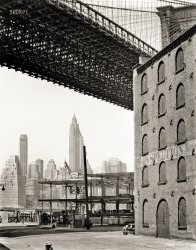
- Louis Chevrolet: 1918
- ... in their Frontenac at the Sheepshead Bay Speedway in Brooklyn, racing in the Harkness Handicap. 5x7 glass negative, George Grantham ... "mechanic" is in your photo of Chevrolet at the wheel in Brooklyn, 1918? I think it may have been my grandfather, but I only have one ... Posted by Dave - 08/06/2012 - 1:57pm -
![Louis Chevrolet: 1918 June 1, 1918. French driver Louis Chevrolet and mechanic in their Frontenac at the Sheepshead Bay Speedway in Brooklyn, racing in the Harkness Handicap. 5x7 glass negative, George Grantham Bain Collection. View full size.
Not Catchy EnoughSee the USA in your Frontenac didn't catch on.
Sacre bleu!Monsieur Chevrolet, he is indeed an impala, no?
IdentificationDo you have any idea who the person identified as the "mechanic" is in your photo of Chevrolet at the wheel in Brooklyn, 1918? I think it may have been my grandfather, but I only have one picture of him, He reputedly worked as a mechanic with Chevrolet.
Thanks.
Linda
[The file for this negative at the Library of Congress, the source for this image, has no other information. -tterrace]
(The Gallery, Cars, Trucks, Buses, G.G. Bain, NYC, Sports)](https://www.shorpy.com/files/images/26953u.thumbnail.jpg)
- Bowling Green Offices: 1919
- ... Brothers Contractors built Ebbets Field, home of the Brooklyn Dodgers. Today we would call that "local sourcing."
Wrong ... Posted by Dave - 05/31/2013 - 2:05am -
![Bowling Green Offices: 1919 Sept. 20, 1919. "Bowling Green Offices, New York." An interesting view of a construction site next to this early skyscraper, and what might be a new Shorpy record for ghost pedestrians. Photo by Irving Underhill. View full size.
Gambling?Is that group of men in the park to the left of the news-stand playing dice?
[I'm guessing some shoe-shining going on. -tterrace]
Still there!And still quite a grand piece of architecture:
View Larger Map
A demolition siteAt this point, as the city begins to rise from the ground. Are those buildings across the street shuddering with fear?
FascinatingThe street life and vehicles are really interesting. The lighting well in the near side of the Bowling Green Buildings shows what you would get for air circulation in the interior offices in the days before a/c, and even into the 1960's. Note the awnings on the windows in the background.
Cunard BuildingThe building shown in the very early stages of construction in this photo became the Cunard Building, named after the famous steamship line. In those pre-Travelocity days the usual way to book travel on one of the grand ocean liners like the original Queen Elizabeth or Queen Mary was by going to the enormous ticketing hall located in the building's lobby. Other shipping lines and transportation-related companies rented space in the building.
Cunard moved out of the building in the late 1960's, and much of the structure actually was vacant for many years. The grand lobby hall became a post office several years later, and the building now houses a variety of tenants. It is located directly across the street from the famous Charging Bull statue.
Note the painted signs on the side of the Bowling Green Building. They were lost to view when the Cunard Building went up, but chances are very good that they are still there, and still readable thanks to being protected from sunlight. If someday the Cunard Building is demolished while the Bowling Green Building still stands, the signs will (literally) come back to light. It has happened before: http://forgotten-ny.com/1998/05/keals-carriage-manufactory/
On both the right and left sides of the photo you can see an elevated train line. That's the Ninth Avenue El, which ran along Greenwich Street in lower Manhattan, one block west of Broadway. It closed around 1940 and the structure came down soon afterward. On the left of the picture there is a subway entrance in Bowling Green, serving the IRT subway line. There is no longer an entrance at that location.
White Star Linewas located up the steps in the center of the building. Mrs. Benjamin Guggenheim called at the White Star Line to get status of her husband following the sinking of RMS Titanic April 1912.
Still no exorcism?By 1919, one would think, advances in shutter mechanisms and the availability of faster films should have eliminated the ghost pedestrian effect without unacceptable sacrifice of resolution, unless, of course, this was taken with a humongous view camera and plates.
[It was exposed on a glass plate in a view camera, plus a small lens aperture would have been used to maximize sharpness and depth of field; all contribute to the necessity of a longer exposure time. -tterrace]
Sept. 20, 1919On this day Babe Ruth tied Ned Williamson's major league mark of 27 HRs, a record that had stood for 35 years previously. A bit over two months later, the Babe left Boston for New York and became a Yankee.
One BroadwayI had read elsewhere that the current 1 Broadway (the building to the left of the Bowling Green Building) was not built as a new building in the early 1920's, but rather had a limestone facade installed over the extant brick. Discussed in more detail in this post at ScoutingNY.
Castle Brothers steam shovelsCastle Brothers Contractors built Ebbets Field, home of the Brooklyn Dodgers. Today we would call that "local sourcing."
Wrong DirectionThe building to the left is 17 Battery Place, still standing, though the roof has been altered. # 1 Broadway is not in the frame, and it would be to the right of this building.
[17 Battery Place is around the corner and two blocks down. -tterrace]
Aha - the subway entrance threw me. I thought I had Battery Park not Bowling Green Park before me.
Mea Culpa.
What's the name again?Are you sure it's the Bowling Green Offices building? I'm just not positive, there are *only* four signs that say so...
On a side note, the construction site next door reminds me of one of my favorite childhood stores, "Mike Mulligan and his Steam Shovel."
Sixth Ave. lineThe elevated line in the picture is the Sixth Avenue line, on Trinity Place. The Ninth Ave line is on parallel Greenwich St, behind those low buildings along Trinity Pl. Out of sight behind the Bowling Green Building, the two lines come together, and run through Battery Park to South Ferry Station. A bit of the jointly used structure is visible at the left of the picture.
The site for the Cunard Building had been acquired by the City and cleared of older buildings, for construction of the BMT subway angling across from Trinity Place (under the IRT on Broadway) to Whitehall Street. After the subway was completed, the site was sold (with a permanent easement for the subway) and the Cunard Building built.
At the north edge of the site, 39 Broadway was the original terminal of the Metropolitan company's 6th Ave line in 1878. The tracks curved from Trinity Place into this site and ended at Broadway. The original intention of the Metropolitan had been to continue across Broadway into Beaver Street, and then turn north paralleling the Third Ave el. At that time the Metropolitan was a competitor of the NY Elevated RR, which owned the 3rd and 9th Ave lines. When the two companies merged (1880?), this terminal was abandoned and the 6th Ave line made the junction with the 9th Ave to go to South Ferry. The company probably sold the Broadway frontage of the old terminal site, but retained a piece on the Trinity Place side, which was used for a terminal for a package express operation of the el. A siding from the 6th Ave line went into the top floor of this building. This would have been one of the buildings cleared for the subway construction.
Hudson Terminal was several blocks to the right, out of the picture. (Two stops further uptown on the IRT, the BMT and the 6th Ave el).
(The Gallery, Irving Underhill, NYC, Streetcars)](https://www.shorpy.com/files/images/SHORPY_3c23200u.thumbnail.jpg)
- Hitler's Children: 1943
- ... Rock and Roll show at the Paramont (it also was at the Brooklyn Fox). The show had a whose who of headliners at the time. His co-host ... Posted by Dave - 03/20/2013 - 5:00pm -
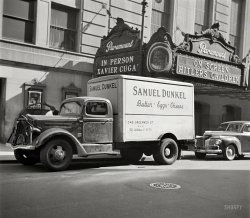
- Prairie Schooner: 1915
- ... Manhattan yesterday, and today a trip will be made through Brooklyn. Tomorrow at noon Charles J. McCormack of Richmond Borough will start ... Posted by Dave - 08/27/2012 - 2:41pm -
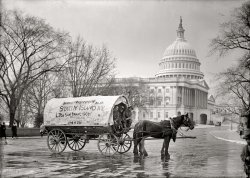
- Tuskegee Airmen: 1945
- ... G. Clifton of San Francisco and Richard S. "Rip" Harder of Brooklyn. View full size. Photograph by Toni Frissell.
Tuskegee I ... Posted by Dave - 07/05/2009 - 3:09am -
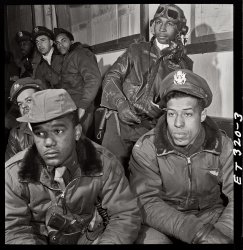
- Leo and Benny's: 1943
- ... Six" in the 1942-43 season, both the Montreal Maroons and Brooklyn Americans (previously the New York Americans) franchises existed ... Posted by Dave - 01/27/2013 - 11:42am -
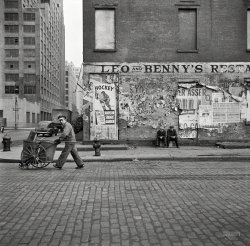
- Dos Hermanos: 1964
- ... memories of taking walks with my grandpop in Manhattan and Brooklyn right around the same time this shot was taken. We'd stop for a slice ... Posted by Dave - 02/28/2021 - 9:13pm -
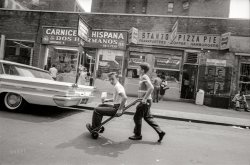
- Maritime Manhattan: 1898
- ... circa 1898. "Produce Exchange with tower, East River and Brooklyn from the Washington Building." 5x7 inch glass negative by William ... Posted by Dave - 12/18/2020 - 12:22pm -
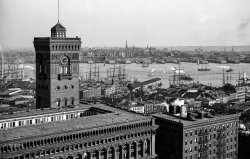
- The Apartment: 1935
- ... hutch-like cabinet. My Grand-mama had it's twin in her Brooklyn, NY, Brownstone walk-up through the 50's. The stove had been up-graded ... Posted by Dave - 09/13/2011 - 10:42pm -
![The Apartment: 1935 July 1935. "Kitchen of an apartment available for rent in the District of Columbia." One of hundreds of photographs taken by Carl Mydans to document housing conditions in the poorer sections of Washington, D.C., during the Depression. 35mm nitrate negative for the Resettlement Administration. View full size.
APARTMENT FOR RENTAdorable D.C. studio apt available downtown. Amenities include charming turn-of-century hardware, gas stove, spacious enamel sink. Quaint period flooring lends provenance to this cozy historic prize. Such potential! 2500/mth, utilities not included. No pets.
Dwelling in the pastMy apartment in the Bronx (1990s) had a built-in just like this. Maybe a little less lopsided than this one, though.
Common bondIt's funny to think that many people in American cities have lived in just such an apartment, even to this day. The place is probably 40 years old in this photo. I've lived in three just like it.
Kitchen archeologyMy NJ apartment in the 1990s looked just like this, too, without the old stove, which was to the distant right of the sink, the whole room being only 4 and half feet wide and 11 feet long. One section of wooden cabinets had been removed to make room for a refrigerator, with a single outlet, and along the wall facing the sink was another, single outlet. Made making toast and coffee at the same time impossible. Not a problem in the 1920's, when mine was built, either, since both would likely have used a stove in that era. The countertop had at least ten layers of oilcloth, wallpaper, contact paper and a top layer of thin plastic that I had to remove at one point before painting it all white. Thought I was being "Modern" - but I guess not!
For Real?That kitchen in Dupont Circle is considered charming and the apartment goes for $3,500 a month.
Clearance issuesUnless it is the focal length playing tricks on me, it would be hazardous to approach the sink while the left burner is on.
[Check the floor. There are four and a half diamonds of space between stove and sink. - Dave]
Speaking of hazardsNewspapers piled atop the burners is a nice touch.
POVIn most of the world today this would be a very luxurious kitchen.
Looks good to meI'm sure the photographer took this shot to illustrate bad housing conditions, but a sink and cabinet almost exactly like that were one of the main selling points for me when I bought my house three years ago -- and I plan to put in a similar linoleum floor.
NYCI lived in a basement apartment in Greenwich Village until 1996. Same sink, much worse cabinetry, slightly better gas stove, linoleum flooring (like the one pictured), only, no windows. Paid $900 a month, and considered myself lucky.
Prolific Carpenters? It seems everyone recognizes that hutch-like cabinet. My Grand-mama had it's twin in her Brooklyn, NY, Brownstone walk-up through the 50's. The stove had been up-graded to white porcelain by then, but many a turkey and pie sat on the sturdy shelf.
(The Gallery, Carl Mydans, D.C., Kitchens etc.)](https://www.shorpy.com/files/images/8a00391a.thumbnail.jpg)
- East River Bridges: 1908
- ... York circa 1908. "Manhattan and East River bridges from Brooklyn." The Brooklyn Bridge, Manhattan Bridge (under construction) and Williamsburg Bridge ... Posted by Dave - 12/04/2018 - 2:17pm -

- War News: 1942
- ... AM to listen to the Ol' Redhead Red Barber announce the Brooklyn Dodgers game. All true blue Flatbush residents were Dodgers fans. ... Posted by Dave - 04/07/2013 - 7:49am -
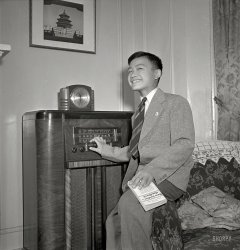
- Sale To-day: 1905
- ... hanged.
1/4 Sizes! From The Daily Standard Union (Brooklyn), March 22, 1907. In tiny text, under Men's Stores in NYC, the first ... the "WOMEN" sign overhead. According to a 1906 ad in the Brooklyn Daily Eagle, Regal's store at Ann & Nassau sold men's shoes, and ... Posted by Dave - 03/01/2013 - 6:44pm -
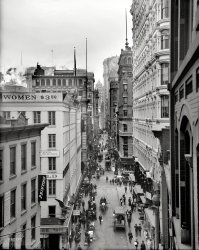
- Spring Forward: 1942
- ... of the occupation in 1918 and eventually made his life in Brooklyn as a welder & pipefitter in the Brooklyn Navy Yard. The pic I've upload shows my Mom holding me in early 1953. ... Posted by Dave - 03/13/2021 - 7:21pm -
![Spring Forward: 1942 April 1942. "Portuguese-Americans in California. Mr. H. Ormond, who is a leading jeweler in San Leandro, came to the United States from the Azores Islands 23 years ago when he was 17 years old. For three years he lived in San Francisco and then moved to Oakland, where he worked in a jewelry store for ten years. In 1932 he opened his own store in San Leandro. Mr. Ormond and his wife have worked long hours to build their establishment and now hold a respected position in the social and business life of San Leandro. Mr. Ormond said, 'I received my education as a boy in the Azores but I have found that all the things that I learned there as well as the principles of honesty and integrity and thrift and industry that my parents taught me have served me well in my adopted country. While I now speak a different language, all the principles of life in the United States and the Azores are the same'." Photo by Russell Lee for the Foreign Information Service of the U.S. Office of Coordinator of Information. View full size.
Assignment: nationalities in CaliforniaIt's astonishing how a Shorpy photo of a man holding a clock in a town outside San Francisco evokes complex but little-known international politics during World War II.
Lee took this photo the same month as the one of Japanese 'evacuees' that recently sparked spirited commentary on Shorpy. The 'Foreign Information Service of the U.S. Office of Coordinator of Information' was in the same alphabet soup as the Office of War Information that is credited on Lee's photo of Japanese-Americans.
It would be interesting to know the specifics of Lee's assignment during April 1942, though one motive is not difficult to figure. Portuguese-Americans were particularly important because neutral Portugal was one of the few places in continental Europe not under strong German influence. (Dictator Salazar ran a government not unlike Spain's, but disliked Franco's ties to the Axis.) That made Portugal a key destination for refugees and a jumping-off place for the Western Hemisphere. (Characters in 'Casablanca' are trying to get there.)
Mr. Ormond's origin in the Azores is particularly noteworthy because both sides were eying the strategic location of that archipelago in the mid-Atlantic. While maintaining neutrality into 1944, Salazar's government gradually increased the Allies' access to the Azores, something that continued into the Cold War--and today.
Tik-Tok-Tik-TokTry to sleep with one of those in the room. Let's just say they keep you up until you surely miss the alarm.
Ask me how I know.
The AzoresThis one has me all nostalgic this morning. My wonderful grandfather, like Mr. Ormand here, came to the US from the Azores. He arrived as a stowaway in Key West circa 1915, worked his way up the coast to his relatives in New Bedford, Mass. and then fibbed his way (he was about 16) into the US Army. He was gassed and wounded in The Battle of Belleau Wood, met my German grandmother as part of the occupation in 1918 and eventually made his life in Brooklyn as a welder & pipefitter in the Brooklyn Navy Yard. The pic I've upload shows my Mom holding me in early 1953. My Dad is on the left, my grandfather on the right. The other two ladies are my aunts, my fathers sisters.
Seems that Mr. Ormond, like my Pop, found a place here and prospered. Part of our unique blended culture.
Enough to Wind Him UpDaylight Savings days were probably not Mr. Ormond's favorite days of the year.
[DST was instituted 365 days a year during the war, so Mr. O got a reprieve. - Dave]
Daylight Savings EYAHHHHHHH!Love the clocks, love the photo, but thinking of all those clocks and Daylight Savings is giving me acid reflux. And I thought **I** had a lot of clocks to change!
Scream AlarmIs that an Edvard Munch clock just over Mr. Ormond's right shoulder?
Wondering how that alarm might sound.
The time of his lifeYesterday I ate a clock.
It was very time consuming but I went back for seconds.
A woof not a screamThe clocks at both of Mr. Ormond's shoulders look like puppy clocks to me. And one of my aunts had the cat clock with the tick-tock tail.
(The Gallery, Russell Lee, Stores & Markets)](https://www.shorpy.com/files/images/SHORPY-8d04013u.thumbnail.jpg)
- Scrambling for Pennies: 1911
- ... we went out in groups in the old neighborhood of downtown Brooklyn. I preferred it to Halloween as the kids actually did tricks on ... Posted by Dave - 09/11/2011 - 8:35pm -
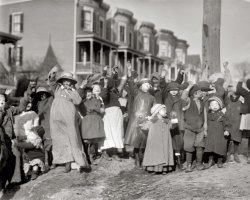
- New York World: 1905
- ... in 1955 for the expanded car ramp entrance to the Brooklyn Bridge. The newspaper folded in 1931 after being sold by the heirs of ... Posted by Dave - 08/01/2012 - 5:47pm -
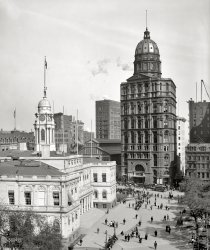
- Light Reading: 1941
- January 21, 1941. "Brooklyn Public Library, Prospect Park Plaza, New York. Popular Room." 5x7 ... Posted by Dave - 09/05/2012 - 7:08pm -
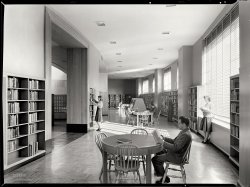
- Infrastructure: 1905
- ... This is old home week for me, both my birthplace (Brooklyn Navy Yard) and childhood nabe show up on Shorpy. We lived at 552 ... Posted by Dave - 08/14/2012 - 10:48am -
![Infrastructure: 1905 New York City circa 1905. "Where the subway is an elevated." 8x10 inch dry plate glass negative, Detroit Publishing Company. View full size.
Does anyone knowWhy and when was the brick head house torn down?
Date of photoI'm curious about the 1905 date, as the Belasco Theater, advertised here, was built in 1907. Perhaps this photo was a few years later?
[The 1905 date is correct. The original Belasco Theatre opened in 1902. Below: Ad from September 1902. - Dave]
125th and BroadwayI do believe this 125th and Broadway on the IRT line. Bedrock in North Manhattan was to dangerous and labor intensive to blast, so an extremely high elevated was the course of action. Spent many a day working there on the signaling during the 1980s. Impressive structure.
Manhattan StreetThis is definitely the 125th street viaduct. We're looking downtown along Broadway. The cross street, Manhattan Street, is present-day 125th Street (the name changed in 1920). There's now a McDonald's on the property where the Belasco Theatre sign is located.
Found it!The building between the frame is gone, but 125th and Broadway seems to be the right spot indeed. The condition of the steel today looks rather bad, I must say.
View Larger Map
Why it's elevatedWest 125th Street actually follows a fault line. It's at a lower elevation than the streets to its north or south, so keeping the subway underground as it crosses 125th would have required a massive amount of tunneling. The result is the only elevated subway line in Manhattan, except for a short segment of the 1 Train in the very northern end of the island.
SinbadPartially obscured at the lower left of the photo is a theater poster for the show Sinbad. A quick look-up at Proquest reveals that the show opened March 13 for a week's engagement at the Windsor theater. This was after a run at the Murray Hill theater that ibdb.com says was 2/27/1905 - 3/4/1905.
An amusing court case emerged from that run in which a chorus girl was said to have attacked a midget in the cast, after he pointed a stage cannon at her. He objected to being dandled by members of the chorus.
My old neighborhood!This is old home week for me, both my birthplace (Brooklyn Navy Yard) and childhood nabe show up on Shorpy. We lived at 552 Riverside Drive from 1947 till 1955. Our building was right up the hill from this spot. This stop had great old wooden escalators in the early 50's, and big heavy wooden turnstiles that made a very satisfying KA CHUNK sound when you put your 15 cent token in and pushed through. And it had a wonderful woody smell, as well. It's all efficient stainless steel and plastic now.
When I lived there there was a Daitch Shopwell supermarket where the McDonald's now stands. And right under the escalator, on the corner of Broadway and Tieman Place, was Claremont Chemists, which I'm happy to say is still there (without its soda fountain).
And there were still trolleys on Broadway, and 125th St led down to the Ferry to New Jersey. And there was a horse drawn vegetable wagon on Broadway as well. Oh, my, the memories are pouring out!
ManhattanvilleThis is a terrific view looking north up Broadway as it crossed Manhattan Street, the signature street of Manhattanville, a once-vibrant town that is now a less distinct section of West Harlem. Except for the magnificent Manhattan Street Station seen in the photo (note the name on the wall of the masonry structure below the tracks), whose name changed in 1921, 17 years after opening.
The Belasco sign on the right is the NE corner of the cross streets. The apartment building under construction is still there, as are most of the surrounding 5- and 6-story apartment buildings that went up in 1905 and 1906 as part of the "Manhattanville Building Boom" (NY Herald) that was a direct result of the new rapid transit line.
The buildings beyond the "Sinbad" sign to the extreme left were at the juncture of West 129th Street and Manhattan Street (now called St. Clair Place and West 125th Street, respectively). Unfortunately, Columbia University just demolished them last year (2010) in the course of expanding its campus into Manhattanville.
This impressive subway structure was considered "worthy of Eiffel" when it opened in 1904. It, and the unseen Riverside Drive Viaduct, are centerpieces of the historic old New York neighborhood I discuss in my book "Manhattanville: Old Heart of West Harlem."
-- Eric K. Washington
(The Gallery, DPC, NYC, Railroads, Streetcars)](https://www.shorpy.com/files/images/4a12442a.thumbnail.jpg)
- The Clerical Army: 1924
- ... of $100,000. Another was 160 electric fans obtained from Brooklyn, N.Y. and put in shape by the typewriter repair force of the new ... Posted by Dave - 08/07/2012 - 2:28am -
![The Clerical Army: 1924 From 1924, another view of clerks calculating the "soldiers' bonus" for the War Department. View full size. National Photo Company Collection glass negative.
Change of SeasonsComparing this photo to the previous posting, I expected to see the same individuals in the same seats. Not so. Not only is this a different day, its an entirely different season. In the previous photo, everyone was dressed in dark sweaters and the electric fans were stationary. Here, light colored short-sleeves abound, the fans are whirring, and the windows are wide open.
Also that very orderly line of wastebaskets has now appeared.
Clear measures of thriftiness in the following article regarding desks and electric fans but no mention of tabulators. If only Haliburton would show similar measures of patriotic "economies" with taxpayer dollars today.
Washington Post, Aug 26, 1924
Bonus Bureau Saves $250,000 in Salvage
Correspondence showing that the coat of equipping offices in the War and Navy Departments to handle the huge task of record searching required under the bonus bill has been reduced by nearly a quarter million dollars by utilizing surplus equipment of various departments, was made public yesterday by the War Department.
"This achievement was made possible by the adjutant general and his assistants and the cooperation of other agencies of the government," Brig. Gen H.M. Lord, director of the budget, wrote to Secretary Weeks in calling the matter to his attention. Gen Lord predicted "further economies" in the same way.
Among the items mentioned by Gen. Lord were 2,000 desks from surplus stocks, including 125 brought from Baltimore in army trucks, which he estimated represented a saving of $100,000. Another was 160 electric fans obtained from Brooklyn, N.Y. and put in shape by the typewriter repair force of the new office, the saving being placed at $2,240. More than $20,000, he added, was saved by reconditioning 350 old typewriters and the salvaging of old office supplies from other government departments added another $10,000.
ChairsAm I right in observing those chairs have no cushions? So, no air conditioning, the room was loud and you'd end the day with a sore behind. I hope the job had good benefits!
40,000 JohnsonsReno Evening Gazette May 20, 1924 Page 6
TO PAY WAR BONUS MEANS GIGANTIC CLERICAL JOB
Associated Press
WASHINGTON, May 20. — Enactment of the war veteran bonus bill into law has laid upon the shoulders of the government departments an administrative task so huge that the figures involved stagger the imagination.
They must explore a veritable mountain of war records. From that mass of musty documents they must pick out the individual war histories of more than 6,898,000 men to provide the data upon which alone bonus payments of any kind can be made.
The daily service of every soldier, sailor or marine who served under the flag in the great war at home or abroad is subject now to minute examination. Through his days of sickness and health, of training at battle abroad the searchers must follow each man through the wilderness of official records. And the bulk of the task must be done in the close-packed filing cases of the War Department where the intimate official story of America at war alone is told.
In those records alone are more than 167,000,000 separate documents, each of which it may he necessary to handle many times before the veterans can all be assured of bonus payments. It will require twenty-seven separate checking operations to make the examination of the file and it will take 2800 clerks to do the work in the War Department alone.
There are amazing stories by the hundreds of thousands among these individual war records. There are tales of highest heroism, of great adventure; tales, too, rich in pathos and sacrifice. They are the war story of each one of the millions of men gathered into the vast volume of the files that must now lie opened for perusal. Among them are the brief records of the many who were called for service but to whom death came in the hospitals almost before they had taken their soldier oaths.
And among them also, never to be recognized for what it is, lies the brief story of America's Unknown Soldier, the record that would show, if it were in the power of man to pick it out, who he was and where he fought and how he died.
By comparison the army's share in the task of record searching overshadows the work that must also be done by the navy and marine corps to carry out the will of congress. In the many files are the records of 5,250,000 men who may make claims. Each must be examined as to the soldier's record before it can be passed upon. In the navy files are the records of 551,736 enlisted men and of 11,880 women who served in the rank of "yeoman-F." in the marine corps there are some eighty thousand records to be combed out.
The War Department files are located here in Washington. They are crowded into the three floors of the historic old arsenal at Washington Barracks, scene of many historic events. It was there that the conspirators were tried for the assassination of President Lincoln and close by is the spot where some of them paid the penalty with their lives.
The documents, grouped in their enveloped Jackets, are now set in soldierly ranks in 7,066 steel filing cases that placed end to end would cover more than five miles. They occupy 2.36 acres of floor space and they weigh 1,080 tons and would fill fifty-four freight cars.
The very compactness of the files adds to the task of ascertaining the individual stories they tell. It is physically impossible to employ more than the 2,800 who will be put to work about them. During the war the draft operations were far greater in scope because they dealt with men by the tens of millions. But that work was decentralized over the entire country and endless clerical help could be used. Now, the product of the draft in fighting manhood alone is to be dealt with, but that record is all here in the crowding file cases.
The War Department, and in cooperation with it, the other two military services, began preparatory work more than two years ago to make ready for the day when bonus legislation might be enacted. At that time Col. Robert C. Davis, then commanding a regiment of infantry at Plattsburg, N.Y., barracks, wan summoned to Washington to begin a study that has resulted in the completion of plans for the gigantic clerical machinery it now becomes his duty to set in motion as he is now adjutant general of the army.
The youngest of American major generals, Gen. Davis served in France as adjutant general of the American expeditionary forces. In that capacity he conceived and created the central war records office of the American land forces in France, an agency unequaled by the Allied armies. He began that work with himself and one clerk as the personnel of what ultimately reached a peak of seven thousand clerks, aside from the many officers it required.
It was against that background of experience that Gen. Davis visualized the task before him in Washington. He saw at once that there were three main elements in the war records of the army, the overseas records, the War Department original records, and the records of the embarkation service. He began his work by calling to his aid the officers who during the war had the greatest knowledge of each of those groups of records and it is with the aid of that staff of less than a score of tried and experienced "two-fisted" men that the plans were shaped in readiness for the bonus bill.
Some idea of the complications that must be met may be gained from the fact that the army files contain the records of 50,328 Smiths who served during the war; 40,101 Johnsons; 28,902 Browns and 27,938 men named Williams. In countless cases initials and even the first and second names are identical, yet the records must separate the one from the other and to each give his proportionate benefit completed on the actual service he tendered in the war.
Another complication foreseen lies in the fact that twenty-three per cent of all these five million potential claimants can not read nor write the English language. A corps of interpreters, having among them knowledge of almost every tongue, must be included in the great office force to deal with the analysis of the records.
The starting point for every veteran in seeking compensation must be the filling out of application blanks already printed. It is here that Gen. Davis fears there may be delay and to reduce that danger as much as possible, he has not only revised the form time and again to reduce it to the simplest possible terms, but has called in his aid the American Legion, patriotic and civic organizations and every ramifying agency of the Federal government over the country to distribute the blanks and to help the veterans fill them in.
"Do not pay fees other than a notary charge," runs the language of an emphatic notice which will be circulated everywhere. "The law prohibits any persons from charging a fee for assistance in the collection of the compensation."
Legion posts everywhere have agreed to serve not only Legion members but all war veterans in filling out the blanks. In the same way every army post or detachment, every national guard center, and every official of the Federal government of whatever kind will give voluntary aid to the veterans as they need it.
Gen. Davis has laid down one other rigid rule. Applications for blanks will not be received by the War Department directly from the veterans. There will be no necessity for that as the blank and the envelopes in which to mail them will be made available everywhere and correspondence direct with the department would crush it under the load of clerical work before it could begin on its real task.
When the applications are received they will go into a "receiving station" and notice will go back to the applicant that his case is in hand. From then on the application will move in orderly way through the ramifications of the files to be checked and rechecked time and again.
There will be reference wherever necessary to the muster rolls of regiments and even small detachments and there will be comparison of finger prints to insure identification. The applications which can be checked in the regular way will move directly through the main channels of the files. Where difficulties are encountered, however, the troublesome application will be promptly sidetracked to a "trouble clerk" for special treatment and in order that there may be no delay and congestion, in the main traffic.
Gen. Davis estimates that with the system he has mapped out it will be possible to attain an average output of thirty-thousand certificates, checked and delivered to the veterans' bureau, every day for six days of every week which means about nine months of work. In order to reach that average, however, the system devised has been made sufficiently flexible to reach a daily total output of seventy thousand certificates as a peak load in the full stress of the work.
The product of all this vast clerical labor will be in the typed certificates forwarded to the veterans' bureau containing the records of each man's service and the computation of the exact amount of compensation to which he is entitled under the law. It is from the War Department, navy and marine corps certificates that the checks for cash payments and the insurance policies will be filled out by the veterans' bureau and mailed to applicants.
WASHINGTON, May 19 -- The bonus bill provides for paid up 20-year endowment policies for veterans and cash payments to those not entitled to more than $50 in adjusted service credit.
Adjusted service credit, which will be the basis also of the valuation of the insurance policies, is figured at $1 a day for home service and $1.25 a day for overseas service, The first 60 days cannot' count. The maximum is fixed at 500 days.
All veterans up to and including the rank of captain in the army and marine corps and lieutenant in the navy would be entitled to the benefits of the bill.
The insurance certificates would be dated next January 1 while the cash payments would be nine months after enactment of the bill.
War Department BuildingI wonder if this and the earlier photo were taken inside one of the War Department temporary buildings that lined the Mall in Washington DC until the 1940's. See this photo from Wikipedia.
[The article below mentions the files being at "the historic old arsenal at Washington Barracks." Another article describes this work as taking place at the adjutant general's offices at Sixth and B. - Dave]
Summers Past...When I was in school, we had similar windows and the tops had to be opened with a long hardwood stick, possibly about 6 feet long, made just for that purpose, which had a hook on the end that fit into the upper windows to pull them open. Sometimes the teacher would appoint the most responsible student to open the top windows, but the stick was stored in a safe place as it had potential to do some damage as a weapon. Another nostalgic memory are the girls in pastel summer dresses and white shoes, the men in seersucker suits, (and I'll bet they all had airy straw hats for streetwear). I am so dependent on looking at these old photos on Shorpy every day, it is now like a tobacco addiction. Thanks for the look back to the way we were, I love Shorpy.
A Shocking Degree of Non-WasteThe most shocking thing ever encountered in Shorpy: a time when the Government was actually trying to spend money prudently.
Tabulating RoomThis appears to be the exact same room as the previous photo, but from an earlier date. The overhead lighting has not been installed, but the windows, fans and desks all appear the same.
(Technology, The Gallery, D.C., Natl Photo, The Office)](https://www.shorpy.com/files/images/31313u.thumbnail.jpg)
- Apartment 17: 1912
- ... the Ruppert Brewery survives today at Pratt Institute in Brooklyn. The tower may be gone, but the works are still with us.
(The ... Posted by Dave - 09/30/2012 - 4:09pm -
![Apartment 17: 1912 January 1912. New York. "Basso family, 2 Carmine Street, Apt 17. Making roses in dirty, poorly lighted kitchen. They work some at night. Pauline, 6 years old, works after school. Peter, 8, works until 8 p.m. Mike, (cross-eyed), 12 years old, until 10 p.m. Father keeps a rag shop." Photo by Lewis Wickes Hine. View full size.
A million barrels of beer on the wallIn late 19th century New York City, George Ehret was its most successful brewer, and the partly obscured line on the calendar page bottom (“1,000,000 barrels sold every year”) was no empty brag. He made a trip to Germany during the First World War, couldn’t get back to the U.S., and the government, caught up in anti-German actions, seized his business. When he managed to return, he worked to straighten everything out, and sponsored a number of pro-American ads for War Bonds. Here's a calendar similar to the one in the Basso home. (Note the Star of David incorporated in the company logo. He might not have made it out of WW II Germany.) What the war couldn’t do to Ehret’s business Prohibition did; the company floundered and in 1935 was bought by the Jacob Ruppert Brewery, also in New York.
[That "Star of David" -- the hexagram or Bierstern (beer star) -- is a symbol of the brewers' guild in Germany. - Dave]
Apartment 17: 1912This is Joe Manning, of the Lewis Hine Project. I did some quick research this morning. In the 1940 census, Mrs. Basso (first name Columbia) was a widow, and lived in NYC with three sons, John (50), Michael (40) and Peter (36). John is not in this picture, but Michael and Peter are. John was working, oddly enough, as a flower dyer. Michael was a trucker, and Peter worked in a print shop. Michael died in New Jersey in 1986. I could find no certain death records for John, Peter or Pauline. I hope I can find more when I get time.
This kitchenlooks neither particularly dirty or poorly-lit for the standards of the day. The room is humble but it looks fairly clean to me, especially considering the activity they're engaged in.
[The magnesium flash took care of the lighting. - Dave]
Jacob Rupert BreweryThe Rupert Brewery, brewers of Knickerbocker Beer, took over the Ehret's Brewery in 1935. Col. Rupert, of the beer company, also owned the NY Yankees. The Brewery was torn down around 1965 and the Rupert Houses, a group of high rise residential buildings was built shortly after that.
Last CallAs a footnote to a footnote, a recent Streetscapes column in the New York Times outlined the rise and fall of Ehret's Brewery. It was demolished in 1969 for an apartment complex. The clock tower pictured in the calendar was intended to be saved, but wound up being destroyed by vandals.
To Joe ManningThis is the first chance I've had to mention seeing you on the CBS Evening News last week. The item Seth Doane did on you and your work with the Lewis Hine photos was excellent, and the interview with Mamie La Barge's granddaughters gave the topic a sense of relevance.
The video can be found here.
2 Carmine St.I'm guessing this is what 2 Carmine looks like from the outside today:
View Larger Map
Maxfield Parrish CalendarI always enjoy seeing these in old photographs. His art was ethereal
The Basso Family through the yearsFollowing up on Mr. Manning's post, I can see the Basso Family on the 1910, 1920 and 1930 US Census. Also on the 1915 NY State Census.
The original family in 1910 was: Antoine (father), Columbia (mother), John (20), Antoinette (14), Michael (10), Edith/Aida (9), Peter/Pietro (7) and Pauline (4).
1915: The father, Antoine (on 1910 Census), either died or skipped town between 1912 and 1915 as the mother Columbia is shown as the head of household in 1915. All sibs are still there at 2 Carmine St.
1920: Antoinette is gone so she either married or died between 1915 and 1920. Probably married as she was in her 20's. Everyone else is still there, but they have moved to 28 King Street which is a few blocks south of Carmine.
1930: Edith is gone so like Antoinette she either married or died between 1920 and 1930. Left are Columbia, John, Michael, Peter and Pauline.
I couldn't find anything on Pauline after 1930.
Clock WorksThe clockworks from the Ruppert Brewery survives today at Pratt Institute in Brooklyn. The tower may be gone, but the works are still with us.
(The Gallery, Kids, Lewis Hine, NYC)](https://www.shorpy.com/files/images/SHORPY_05486u.thumbnail.jpg)
- Out for a Spin: 1904
- ... County. The item below is from the Oct. 30, 1915, issue of Brooklyn Life. - Dave]
(The Gallery, Cars, Trucks, Buses, DPC) ... Posted by Dave - 02/23/2019 - 12:06pm -
![Out for a Spin: 1904 Circa 1904. "Patchogue Avenue, Manhanset Manor, Shelter Island, N.Y." 8x10 inch dry plate glass negative, Detroit Photographic Company. View full size.
If you don't like my drivingkeep off the grass.
A Country Song Comes to Mind"Jesus take the Tiller!"
Wondering1902 Flint Roadster, maybe?
One of 149?The vehicle in view appears to be a 1903 Pierce Stanhope, of which 149 were made.
The carThat looks like a Studebaker Electric.
Not an electricThere's a radiator under the front valence (which is hiding a folded-up seat).
LimericksThere once was a man from Nantucket
Who kept all his cash in a bucket.
His daughter, named Nan,
Ran away with a man
And as for the bucket, Nantucket
Pa followed the pair to Pawtucket,
The man and the girl with the bucket;
He said to the man,
"You're welcome to Nan",
But as for the bucket, Pawtucket.
The pair followed Pa to Manhasset,
Where he still held the cash as an asset,
But Nan and the man
Stole the money and ran,
And as for the bucket, Manhasset.
(Yes, there is another Man from Nantucket limerick, but we won't go there)
Maybe they're lost?I'm having some trouble making sense of the address given in the description here. In the present day, at least, Manhasset and Patchogue Avenue are in two very different parts of Long Island. And Shelter Island sits even farther away, out between the forks at the far eastern end of Long Island.
The carI found a photo of another example of the car, in a similar position, for comparison.
Tough Life?Oh, the poverty in this neighborhood!
8 Gardiner Way
This was somewhat difficult to find, as "Patchogue Avenue" has since been renamed and there is no town today called "Manhasset" on Shelter Island. Thank you to the Rumsey Historical Map Collection!
Where should I park, dear? "Park the car anywhere you like, honey!"
RE: 8 Gardiner Way | Maybe they're lost?If memory serves, there was a Manhasset Hotel on Shelter Island (on the north shore of Shelter Island, near the modern day Gardiner Way) that burned down in the early 1900s --named for the Manahasit Native American tribe local to the area; the town of Manhasset that is quite a bit west of Shelter Island on the north shore of Long Island was also named after them.
I believe there were even some old photos of the hotel posted here a while back.
[You are perhaps thinking of Manhanset (not "Manhasset") House, on Dering Harbor. - Dave]
Yup; Long Island I'm good at; spelling, not so much. Lots of locales on Long Island named with variations of the local Native American tribes of the area.
The house pictured can also be found at this address: 8 Gardiner Way, Dering Harbor, New York.
[Further research reveals that the village at the time was called Manhanset Manor (location of the Manhanset House and Cottages resort); in 1915 the name was changed to Dering Harbor. The Library of Congress errs in correcting the place name "Manhanset" to "Manhasset" in these Shelter Island captions; Manhasset is much farther west on Long Island, in Nassau County. The item below is from the Oct. 30, 1915, issue of Brooklyn Life. - Dave]
(The Gallery, Cars, Trucks, Buses, DPC)](https://www.shorpy.com/files/images/SHORPY-4a11427a.thumbnail.jpg)
- Steam Players: 1907
- ... 1860's and still used today. Roebling also designed the Brooklyn Bridge.
"This way to join the Paddlewheel Navy" says ... Posted by Dave - 10/04/2015 - 11:38pm -
![Steam Players: 1907 The Ohio River circa 1907. "Along the levee at Cincinnati." The Coney Island Co. sidewheeler Island Queen and her retinue. 8x10 glass negative. View full size.
The side wheeler just moved up riverGoogle street view.
[That was a sternwheeler, originally the steam towboat John W. Hubbard, built in 1936. It was moved to Newport in 2014. -tterrace]
Nooner!Taking a short nap on the riverbank next to the barge?
Side wheelersWhat a sight it must have been to see all those big paddlewheel boats! I grew up in a Mississippi River town. There was an old paddlewheel boat rotting on the shore when I was a kid. It always set my mind dreaming of the days in this photo.
Teeny tiny and gigantic!Those three small boats in the foreground give some scale to the Queen in her magnificence. I once lived in a houseboat like the closest one, but the teeniest one looks no bigger than a camper!
And the warehouses look mobile as well!
Bridge to KentuckyThat's the John A. Roebling Suspension Bridge in the background. Built in the 1860's and still used today. Roebling also designed the Brooklyn Bridge.
"This way to join the Paddlewheel Navy" says StanOllie is noticing the mud on his shoes and saying "Here's another nice mess you've gotten me into." What a great comedy team they were!
More hogging chainsMore hogging chains in evidence.
This time even on the floating pier.
Version 1.0This is the first of two boats named Island Queen. It was built at the Cincinnati Marine Railway Company in 1896, 281.4 feet long, 42.6 feet wide. Destroyed by fire in 1922.
SS TrystI wonder what was the function of the small, curtained vessel moored near the shore. It lacks the stovepipe of a 'live aboard'. Cleopatra's mini-barge?
(The Gallery, Boats & Bridges, Cincinnati Photos, DPC)](https://www.shorpy.com/files/images/SHORPY_4a22288a.thumbnail.jpg)
- Colossus of Pike Street: 1936
- ... Street and no further away based on the appearance of the Brooklyn shore in relation to the bridge's western pier. I think it is safe to ... Posted by Dave - 01/11/2016 - 11:17am -
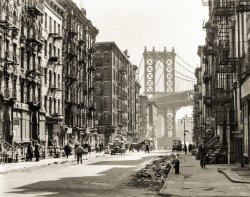
- Manhattan Terminal: 1906
- New York circa 1906. "Manhattan entrance to Brooklyn Bridge." The street railroad terminal. Detroit Publishing Company ... Posted by Dave - 07/31/2012 - 2:56pm -
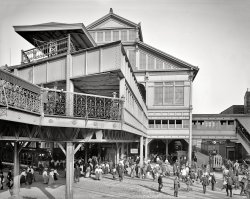
- A Hot Mess: 1900
- New York circa 1900. "Mess boys, Brooklyn Navy Yard Hospital." 8x10 inch dry plate glass negative, Detroit ... Posted by Dave - 05/08/2015 - 11:49am -
![A Hot Mess: 1900 New York circa 1900. "Mess boys, Brooklyn Navy Yard Hospital." 8x10 inch dry plate glass negative, Detroit Publishing Company. View full size.
Coming or going?Are they coming from feeding or going to feed the patients? The plates appear to have left overs on them and judging by the loose grip on the pail, it's almost empty.
I was a Tin Can sailor during the 60s. I seem to remember the mess cooks wearing whites even if the uniform of the day was blues. Each division had to supply two or three mess cooks depending on the size of the division. Maybe that's why the two different uniforms.
I'm no expertbut in the days before the Navy issued dungarees for work, didn't sailors wear old worn-out dress uniforms for that? Seems that even the engine room crews in these old photos are dressed this way.
Appliances do helpModern appliances, washing powders and detergents not only give a hand to the working homemakers of either sex to keep the house shipshape and copper bottomed. They also help the modern sailor to look neat and clean, freshly machine-washed and electric-ironed most of the time. Not to mention that air conditioning keeps the mildew out. Not having to man-haul thousdands of tons of coal every other week may help, too.
By the way, is that hat on the blue sailor's head regular issue? Looks like a floppy hat used by modern sport fishermen.
Heck,you never messcranked? I only wonder why blues and whites.
Uniform Of The DayWhen I was in the Navy (early to mid-60's) the Uniform of the Day was promulgated by the Naval District. For enlisted personnel it was either the dress or undress (working form) of Whites (our sailor on the right) or Blues (on the left) but definitely not both on the same day.
Shared memoriesWith JohnMB, Glenn555 & landtuna:
Hot pot! Make a hole!
CuspidorMaybe it's my 21st century sensibilities, but it's pretty unnerving to see a cuspidor on a hospital floor.
[Better to spit on the floor? -tterrace]
Yes, they are a mess.I was in the Navy (late 50's). We kept out uniforms clean and pressed. We wore them such that we would at least look neat. These mess boys could not look any worse, but let us not forget at that time they were our heroes.
Gas or electric lightYou still have a choice.
If you flip a 'dixie cup'The hat worn by the swabby on the left is likely a 'dixie cup' flipped upside down, or turned inside out. When I served, the POD would specify the uniform of the day. In this case, it may be a watch-stander is helping the mess decks get their food delivered while it is still hot. They are no longer around to answer our insipid questions. I thank them for their service posthumously.
(The Gallery, DPC, Medicine, NYC)](https://www.shorpy.com/files/images/SHORPY-4a14998a.thumbnail.jpg)
- Summer Games: 1938
- ... elaborate stoops like these are more characteristic of Brooklyn than of Manhattan. There's a good chance that the picture is from one of the older Brooklyn neighborhoods such as Park Slope, Prospect Heights or ... Posted by Dave - 01/18/2014 - 8:01am -
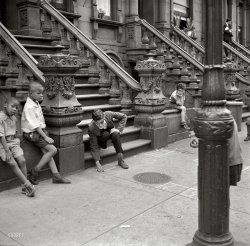
- Good Night, Mrs. Calabash: 1952
- ... Great talent! Also had a nice role in "It Happened in Brooklyn", but more of a straight role, no major buffoonery, just a nice normal ... Posted by Dave - 06/06/2013 - 12:44am -
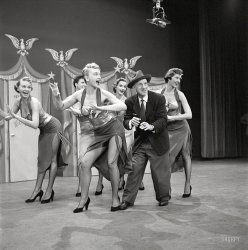
- World Series: 1912
- ... because the Yankees, Giants (NY that is) and/or Dodgers (Brooklyn, that is) were usually in the series.
Variety Even though a ... Posted by Dave - 09/11/2011 - 8:24pm -
![World Series: 1912 "Baseball, Professional. Crowds at scoreboard." Watching the 1912 World Series courtesy of the Washington Post on an electro-mechanical scoreboard that looks something like a big pinball game. In the years before the first radio broadcasts in the early 1920s, newspapers, linked to reporters by telephone, wire service or "wireless telegraph," provided live coverage of sporting events like prizefights and baseball games to crowds on the street, with announcers and scoreboards giving play-by-play results. Harris & Ewing Collection glass negative. View full size.
Men without hatsI see two!
The WillardI'm a little confused looking at this photo. I know that the Washington Post was once on E St. just north of what is now called Freedom Plaza. And there was a Hotel Johnson at 13th and E, which would be consistent with the idea that this is shot looking east down E Street from about 14th Street.
But I'm confused because the building looming in the background looks like the Willard, which would be behind the camera if I'm right. Was there a building at 12th and Pennsylvania that looked exactly like the Willard?
[Update: We are looking down E Street at the Raleigh Hotel. - Dave]
Officer! Arrest That ManYou there! Without a jacket or a hat. Come with me. You are under arrest as either a vagrant or a visitor from the future - and with those suspenders and bow tie, the latter is obviously not the case.
E StreetI think that this view is indeed looking eastward along E street. At some point, Mr. Foster's shop moved, a careful study of the buildings show that they are different. An alternative view of some of the buildings, and the "Velvet Kind" sign, is seen in the nighttime Washington Noir photo.
The 1400 block of E street is visible in the background of one of the many views of the Hayes roadster. But this puzzles me. The National Theater building, with the blocky projecting bays, is perhaps seen in both. However, the Munsey Building, the large white block built in 1905, is seen behind the roadster but where is it in this photo?
[In 1912 Mr. Foster's shop was on 14th Street across from the Willard (ad below from December 1912). The store in the 1924 photo, when he had two locations, might be the one at 1229 Pennsylvania Avenue. In any event, that's the Raleigh Hotel in the background. The cupola was at 12th and Pennsylvania, so this would indeed seem to be E Street. - Dave]
Update: There is a reference in the Post in 1908 referring to address of National Remembrance Shop at 1333 E street. The Historical Society of DC has an image of the corner of 14th and E showing Mr. Foster's at the 503 14th site. Note the trusty policeman directing traffic in the foreground.
Washington Post, Apr 26, 1914
The Munsey Trust Company yesterday bought the property at 1335 E street, occupied by William A. Engel, who conducts a saloon, bowling alley, and restaurant. The purchase of the property gives the Munsey Trust Company ownership of all the buildings and ground between the New National Theater and the Washington Post building.
The trust company announced that an eleven-story office building is to be built on the site now occupied the by Shoomaker company and Engel, to adjoin the Munsey building. The new building will be of the same height as the Munsey building, and will be surmounted by a tower. The entrance of the present Munsey building will be changed. Work on the new building will begin June 1. McKim, Mead & White, of New York, will draw the plans for the building.
So I take from this, that the large columns in this photograph are the entrance to the original Munsey building. when the building was expanded The facade was rebuilt to the appearance seen in the roadster photo. This suggests the roadster photo was probably taken after 1915.
The World Series is the Big EventThe best thing of all is that this crowd is gathered on a Washington street to watch the results of a World Series played by franchises in two other cities.
Subway SeriesThere was a time, before TV sets were common in homes, that people would gather in front of stores that sold them. In most NYC neighborhoods, they were radio repair shops. There they watched the telecasts the same way the folks in this picture watched the scoreboard, but the crowds were nowhere as large as this. However, in the 1940's and 50's there was local interest because the Yankees, Giants (NY that is) and/or Dodgers (Brooklyn, that is) were usually in the series.
VarietyEven though a casual glance reveals a sea of derbies and homburgs, careful examination reveals quite an interesting variety of hat styles and "bashes" (crown shapes).
(The Gallery, D.C., Harris + Ewing, Sports)](https://www.shorpy.com/files/images/01551a.thumbnail.jpg)
- Larry's Beer Garden: 1934
- ... was the Fulton Fish Market, and a few blocks farther, the Brooklyn Bridge.
(The Gallery, Boats & Bridges, Gottscho-Schleisner, NYC) ... Posted by Dave - 09/13/2011 - 1:59pm -
























